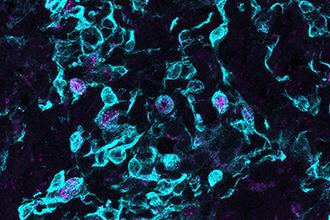New quality control revealed in immune T cell development

Microscopic view of cells in the thymus, an organ located just above the heart that trains immune T cells to defend the body against viruses and bacteria. Credit: Walter and Eliza Hall Institute, Australia
T cells are an important component of the immune system, orchestrating immune responses in reaction to infections. The thymus is like a 'school' for T cells, training them how to fight infections and eliminating the 'naughty' cells that have the potential to launch dangerous autoimmune attacks on the body's own tissues. Only a small proportion of the T cells that begin their development 'graduate' and are allowed out of the thymus, into the bloodstream – the rest do not survive.
Dr Charis Teh, Dr Daniel Gray and colleagues made the discovery, published in the journal Nature Communications, when investigating the link between faulty LUBAC and T cell defects.
Dr Teh said the team were surprised to discover that LUBAC was important for a very late stage of T cell development within the thymus.
“Since the function of the thymus was discovered by Professor Jacques Miller almost 60 years ago, there has been an intense research effort to reveal the intricate details of how immune T cells develop,” she said.
“By showing that LUBAC is essential for T cell development, we also revealed a new stage of 'T cell education' that had not previously been appreciated. We're excited by the prospect that this new checkpoint may be important for ensuring autoimmune T cells are not allowed to complete their development,” she said.
“In most people, this prevents the development of autoimmune diseases such as type 1 diabetes and multiple sclerosis,” Dr Teh said.
Dr Gray said the team hoped that by understanding the newly discovered process better, they may be able to develop new approaches to 'switch off' autoimmune T cells. “This may have therapeutic applications in the future for treating autoimmune diseases,” Dr Gray said.
“Another interesting aspect of this research relates to rare inherited immune disorders caused by defects in the genes that encode the components of LUBAC. Our research has provided new insights into how these disorders are linked to faulty T cell function. This may inspire to new immune-based therapies for these conditions,” he said.
###
The research was supported by Diabetes Australia, the National Health and Medical Research Council, Cancer Australia, the Australian Research Council, the Leukemia and Lymphoma Society (US), the Wellcome Trust (UK), and the Victorian Government Operational Infrastructure Scheme.
Media Contact
All latest news from the category: Life Sciences and Chemistry
Articles and reports from the Life Sciences and chemistry area deal with applied and basic research into modern biology, chemistry and human medicine.
Valuable information can be found on a range of life sciences fields including bacteriology, biochemistry, bionics, bioinformatics, biophysics, biotechnology, genetics, geobotany, human biology, marine biology, microbiology, molecular biology, cellular biology, zoology, bioinorganic chemistry, microchemistry and environmental chemistry.
Newest articles

A universal framework for spatial biology
SpatialData is a freely accessible tool to unify and integrate data from different omics technologies accounting for spatial information, which can provide holistic insights into health and disease. Biological processes…

How complex biological processes arise
A $20 million grant from the U.S. National Science Foundation (NSF) will support the establishment and operation of the National Synthesis Center for Emergence in the Molecular and Cellular Sciences (NCEMS) at…

Airborne single-photon lidar system achieves high-resolution 3D imaging
Compact, low-power system opens doors for photon-efficient drone and satellite-based environmental monitoring and mapping. Researchers have developed a compact and lightweight single-photon airborne lidar system that can acquire high-resolution 3D…





















